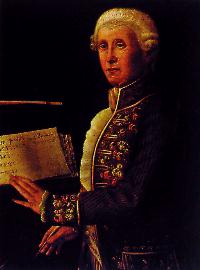
o

Perle del Barocco cdc 008 Tartini/Boccherini cdc 017/018 Perle/Paganini cdc 008/009 Real Audio: Quintetto in Mi maggiore (Minuetto con un poco di moto) |
Luigi
Boccherini (born in Lucca 19 February 1743, died in Madrid 28
May 1805) was a composer and cellist who was a true heir of the
great instrumentalists who raised the Italian school of music
of the eighteenth century to brilliant heights. As a composer
he produced music which was marked by freshness of melody, ease
of inspiration, and fluidity and economy of style. As a cello
player he was a virtuoso recognised and appreciated by all his
contemporaries. |
© P&P - Promozione e Produzione, Rome.